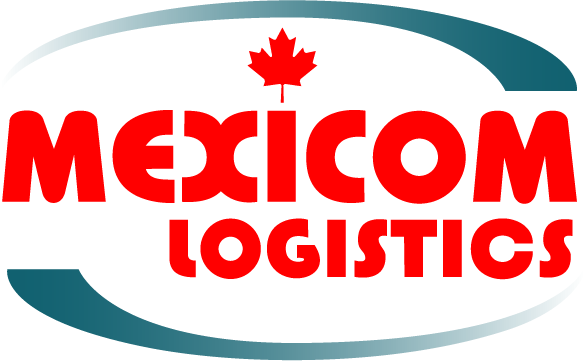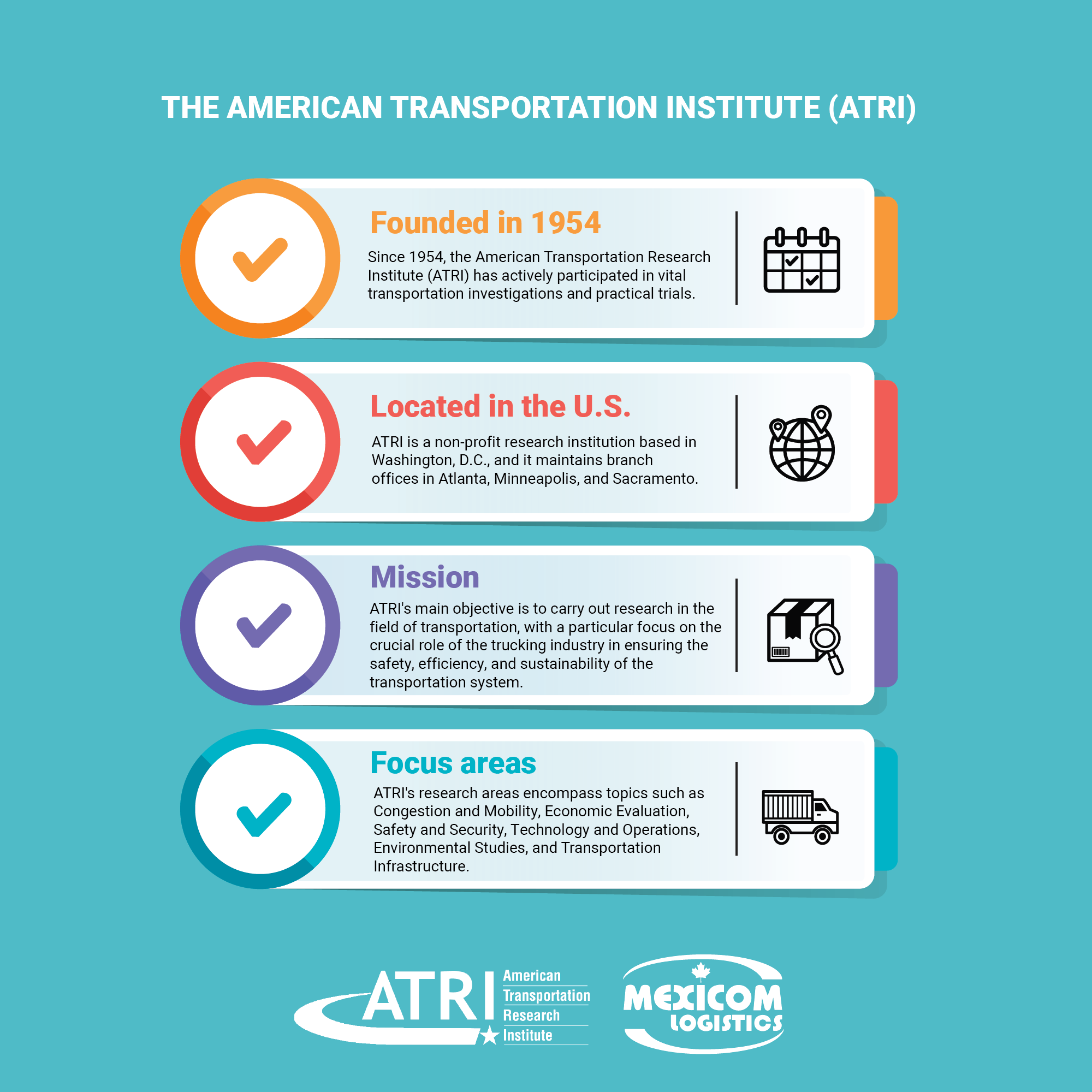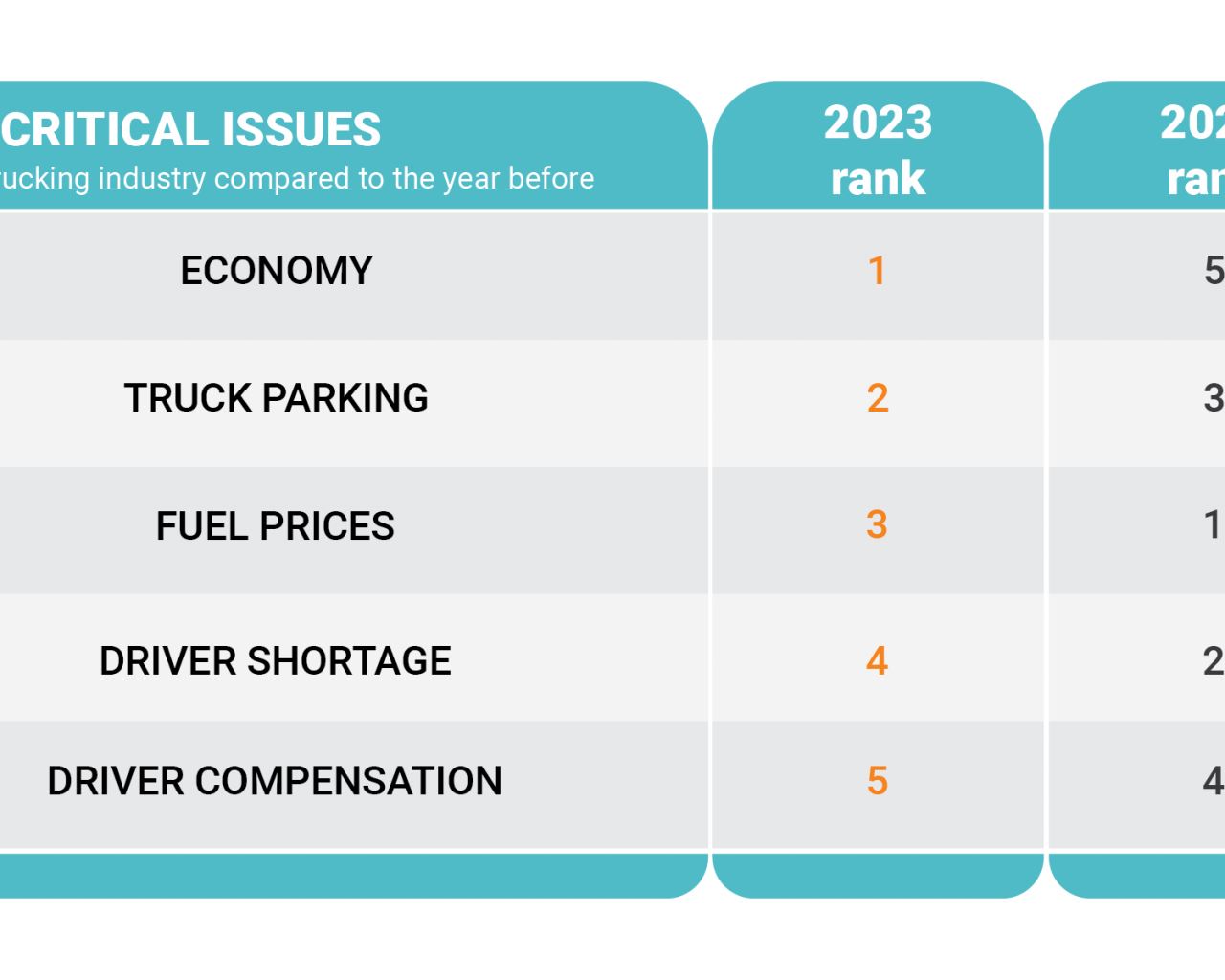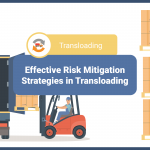Critical Issues Currently Happening in the American Trucking Industry, Impacting the Whole North American Supply Chain
La version française sera disponible sous peu
The trucking industry has been faced with some serious critical issues during this year. High inflation made things more expensive for both consumers and producers. Plus, interest rates went up, making capital costs higher. Trucking prices also dropped throughout the current year, mostly because of problems in important industries like agriculture, housing, and manufacturing. Retail sales struggled to keep up with inflation, and retailers had too much stock.
As a result, the industry saw a decrease in job opportunities and at the same time, the number of registered carriers stayed almost the same. The American Transportation Research Institute (ATRI) is the organization primarily responsible for investigating and understanding the trucking sector’s complexities. As well as its wide-reaching impact throughout North America.
What are ATRI’s operations and responsibilities?
The American Transportation Research Institute (ATRI), a non-profit organization dedicated to transportation studies and research, was surveyed to identify the top concerns of motor carriers and truck drivers. With a history of nearly two decades, this survey ranks the primary issues within the trucking industry. The goal is to ensure safe, efficient, and reliable transportation. ATRI’s research areas include studying traffic congestion and mobility, economic analysis, safety, and security, technology and operations, environmental impact, and transportation infrastructure. They have extensive experience in various aspects of commercial vehicle operations and have been involved in national freight analyses, technology research projects, and field tests.
ATRI conducted a survey to identify the most critical issues of 2023, and the responses indeed proved to be highly critical. Survey responses were received from over 4,000 industry stakeholders spanning North America. Of the total respondents, motor carrier executives and personnel accounted for 47.8%, while professional truck drivers constituted 29%, and other industry stakeholders, including industry suppliers, driver trainers, and law enforcement, made up 23.2% of the participants.
Top Critical Issues in the Trucking Industry Compared to the Previous Year
5 Key Critical Issues in the Trucking Industry During 2023
1. THE ECONOMY
The ATRI survey reveals that the economy has taken the top spot as the most critical issue in the transportation sector, with an Industry Concern Index of 100.
The American trucking industry plays a crucial role in North America’s freight transportation, connecting Mexico, Canada, and the United States. In 2023, the industry faces numerous critical issues, with the economy taking the lead. The American Transportation Research Institute (ATRI) explains how freight transportation across North America will impact the economy and create a critical issue all through the Northern countries in America. The economy affects motor carriers and drivers through inflation, higher interest rates, increased diesel costs, lower freight demand, and reduced rates. According to the survey conducted by The American Transportation Research Institute (ATRI), the “Economy” topic rose four spots this year to be the top-ranked industry issue. Professional truck drivers, motor carrier executives personnel, and stakeholders are the people directly affected by this critical issue. They were the ones who responded that “the economy” was the number one current issue that needed to be addressed with urgency.
The economy’s influence on the trucking industry in the United States, Canada, and Mexico spreads across the entire North American freight transportation landscape which connects different matters that make this an alarming concern. We will dissect these topics to better understand why the economic issue is being top-prioritized and critical to the supply chain.
Cross-Border Trade
The interconnectedness of the North American economy heavily relies on cross-border trade. Inflation, high-interest rates, and increased diesel costs can disrupt this trade flow by affecting the cost-efficiency of transporting goods between these countries. The economic impact of cross-border trade is significant. It generates jobs, stimulates economic growth, and supports a wide range of industries, from agriculture to manufacturing. Moreover, cross-border trade is an essential driver of economic well-being for all three countries.
Logistics and freight transportation companies are specialists in handling cross-border shipments, and they play a crucial role in ensuring the smooth flow of goods. All the current disruptions in the economy are generating an impact on several logistics networks, leading to delays and increased costs that disrupt the interconnected markets of North America. The deep interconnectivity between Canada, Mexico, and the United States highlights the importance of a seamless and efficient cross-border transportation system.
In finding solutions to these challenges, utilizing services that are strategically positioned in cross-border regions is key. Navigating the border crossing in Laredo and finding tips and resources will be beneficial to a smooth and efficient cross-border trade experience. Services like the ones provided by Mexicom USA which are situated between Laredo, TX, and Mexico are essential. Their proximity to the border allows them to navigate the complexities of cross-border trade efficiently, providing a smooth and well-executed experience. Leveraging the expertise and resources of services in this region can be a valuable approach to addressing the challenges of cross-border trade and ensuring the continued success of North American freight transportation networks.
Supply Chain Disruptions
Supply chain disruptions, particularly those affecting freight demand and rates, can have a significant impact on the economy of the three North American countries. When freight demand is lower and rates are reduced, it often indicates imbalances within the supply chain. Such imbalances can result in production delays, transportation bottlenecks, or unexpected severance. Lower demand for transporting goods can signal a slowdown in manufacturing and this is one of the biggest sector providers to the transportation industry. Contributing to job losses can result from supply chain disruptions, again within the logistics and manufacturing sectors. It also impacts consumers through higher prices and shortages of goods, affecting the cost of living. To fight this affair is essential to know how to cultivate resilience in your supply chains, especially during tough economic times.
Transportation Cost
Economic challenges, such as inflation and higher interest rates, can significantly raise operational costs for trucking companies and increase expenses for maintenance and labor. When transportation costs rise, it often results in higher prices for goods and services. These price hikes can affect consumers by eroding their purchasing power, meaning individuals across North America might need to allocate a larger share of their income for everyday expenses. In essence, fluctuations in transportation costs can ripple through the economy, impacting everything from household budgets to the competitiveness of industries. Addressing these challenges is critical to maintaining economic stability and ensuring that the transportation sector continues to function as an economic engine for the region. We prioritize the discovery of effective methods to cut costs in freight transportation. That’s why we’ve developed a comprehensive guide to assist your business in identifying the optimal ways to reduce costs on freight transportation.
Environmental Considerations
These are pivotal for the transportation sector and have significant economic implications for Canada, Mexico, and the United States. Prioritizing sustainability in transportation operations leads to resource efficiency by reducing fossil fuel consumption and conserving natural resources. Rising diesel costs can influence transportation choices and the adoption of more fuel-efficient, eco-friendly technologies. The broader implications of such choices have implications for environmental policies and regulations across these regions. Considering these effects will lower operational costs, making the industry more resilient to resource scarcity and price fluctuations. Sustainable practices also reduce healthcare costs by minimizing pollution-related illnesses.
They stimulate economic growth through infrastructure investment and job creation. Compliance with stringent environmental regulations enhances trade opportunities and fosters innovation in cleaner technologies. By adopting environmentally responsible practices, the transportation sector ensures regulatory compliance, safeguarding financial stability and contributing to overall economic resilience. It is crucial to consider all factors when seeking the best solution for conserving natural resources, while also evaluating whether transitioning heavy trucks to electric or hydrogen power in North America represents an optimal choice.
2. TRUCK PARKING
The ATRI survey reveals that truck parking is the second-ranked concern and the most critical issue in the transportation sector, with an Industry Concern Index of 94.0.
Addressing the shortage of truck parking spaces, survey respondents express the desire for truckers to champion a dedicated federal funding program aimed at enhancing truck parking capacity at strategically important locations. This need is underscored by the alarming statistic that estimates just one parking spot for every 11 truck drivers, emphasizing the urgency of action. Notably, this shortage is a major concern in the US, but it has a ripple effect on the supply chain that connects Canada and Mexico, underscoring its broader regional impact. Additionally, respondents call for proactive efforts to encourage local and regional governments to streamline regulations that hinder the construction and expansion of truck parking facilities. Even though there are more private parking options for trucks, the problem of not having enough truck parking spots, especially in big cities, is still there.
Local rules and regulations often restrict or completely forbid truck parking. There is some good news regarding truck parking in big cities. In New York City, they passed a law to make special parking spots for large trucks. This means they’re trying to make it easier for trucks to park. Around 34.6 percent of the people who took the survey prefer the idea of getting rid of rules that make parking hard and finding new places for trucks to park in their own cities or regions. This kind of approach could be applied in all major cities with a lot of business cargo, like Mexico City, and in all significant transportation hubs in Canada.
We emphasize our capability to deliver efficient solutions when tackling the challenges faced in cities with high cargo traffic. One critical asset in this endeavor is Mexicom USA’s strategically positioned warehouse in Laredo, Texas. This central hub efficiently offloads and distributes cargo, reducing the need for extensive parking and minimizing demand. Such facilities set a valuable example for future solutions, highlighting the importance of making the most of existing assets to enhance efficiency and address truck parking issues in high-traffic urban areas, ultimately ensuring smooth cargo flow and reducing environmental impact.
3. FUEL PRICES
The ATRI survey reveals that truck parking is the third-ranked concern and the most critical issue in the transportation sector, with an Industry Concern Index of 87.7.
The report also delved into the issue of fuel prices, which ranked third in importance. It shed light on the usage of various truck fuels, revealing that the adoption of alternative fuels remains relatively low, with some fleets having just one alternative fuel truck. Fuel costs have exhibited fluctuations throughout the year. Initially, prices were on a decline due to a slowing economy, but in July, they began to rise again. By September, the average price per gallon stood at approximately $4.56 USD (average in the U.S.). These soaring diesel prices present a significant challenge, particularly for owner-operators, who have consistently ranked fuel prices as their top concern for three consecutive years.
ATRI addresses this critical issue by putting forward possible solutions for high fuel prices:
- ADVOCATE FOR FEDERAL ACTIONS – The majority of respondents (68.0%) support stabilizing the nation’s fuel supply through federal action. This entails expanding refining capacity, increasing domestic drilling, or utilizing the Strategic Petroleum Reserve (SPR).
- RESEARCH FUEL FACTORS – With geopolitical events and weather impacts affecting fuel prices, (23.5%) of respondents advocate for more research to understand the complex dynamics influencing the nation’s fuel supply.
- QUANTIFY IMPACT OF ALTERNATIVE FUELS – (6.3%) of respondents believe the best approach is to quantify the effect of alternative and renewable fuels on motor carrier operational costs.
A crucial factor contributing to this disparity can be attributed to the interplay of multiple variables, including geopolitical events, supply chain disruptions, and market dynamics. These variables influence the cost of refining and distributing diesel fuel, creating a situation where diesel prices may fluctuate independently of crude oil price trends. This intricate relationship between diesel prices and the supply chain in North America, encompassing Mexico, Canada, and the United States, underscores the broader impact on the region’s logistics and transportation. Understanding these dynamics and their implications for the supply chain is vital for maintaining the efficiency and reliability of cargo transport. explore the insights offered in the article: [Infographic] Why Did Diesel Prices Increase More Than Oil Prices?
4. DRIVER SHORTAGE
The ATRI survey reveals that truck parking is the fourth-ranked concern and the most critical issue in the transportation sector, with an Industry Concern Index of 81.8.
ATRI’s research reveals that the trucking industry currently faces a significant driver shortage, with an estimated need for approximately 64,000 additional drivers in the United States. Despite this pressing need, female truck drivers remain underrepresented, constituting less than 10 percent of the total truck driver workforce. Remarkably, ATRI’s studies indicate that female drivers exhibit a higher level of safety in comparison to their male counterparts.
Driver shortages have significant ripple effects throughout the entire supply chain connecting North America. When there aren’t enough qualified CDL drivers. In the United States, a commercial driver’s license (CDL) is a mandatory license for operating oversized and heavy vehicles, such as trucks. These unqualified drivers can lead to delays in delivering goods. This affects not only trucking companies but also businesses relying on timely deliveries. The shortage can disrupt the smooth flow of products between the United States, Canada, and Mexico, impacting the broader North American supply chain. The ramifications extend to increased costs, decreased efficiency, and potential delays in getting goods to their destinations, ultimately affecting the economic interconnectedness of the region.
To address the driver shortage in Canada, the US, and Mexico in a strategic manner, we can look for a comprehensive understanding of the issue, and find not-so-obvious solutions to the truck driver shortage.
One smart approach is to invest in driver recruitment and retention strategies, focusing on creating an attractive work environment. This may include competitive compensation packages, improved working conditions, and better benefits. Additionally, fostering a supportive and inclusive workplace that actively encourages the participation of women in the industry can broaden the pool of potential drivers. Furthermore, exploring innovative technologies that enhance driver productivity and safety, such as telematics and driver-assist systems, can make trucking careers more appealing.
Collaborating with educational institutions to provide comprehensive training and support for aspiring drivers is also a proactive step toward alleviating the shortage. In essence, the smart way to solve the driver shortage involves a multi-faceted approach that combines better working conditions, technological advancements, and inclusive recruitment strategies.
5. DRIVER COMPENSATION
The ATRI survey reveals that truck parking is the fifth-ranked concern and the most critical issue in the transportation sector, with an Industry Concern Index of 76.1.
Driver detention at customer facilities is an ongoing concern within the trucking industry, often rated as a top issue by truck drivers and motor carriers alike. This research, backed by shipping industry associations, aims to gather quantitative data to assess the impacts and costs associated with driver detention. The ultimate goal is to develop strategies for reducing detention times and improving overall efficiency.
The ATRI’s proposed strategies to address the critical issue of how driver compensation is being handled:
- Quantify Compensation Impact – This strategy focuses on measuring the economic effect of compensating drivers for all hours worked, including detention time and congestion delays.
- Analyze Compensation Models – Beyond just raising pay, this strategy involves examining various truck driver compensation models and their impact on driver satisfaction and productivity. ATRI’s research has identified alternative pay models like pay-per-load, percentage of the bill, and guaranteed salaries, which differ from the traditional pay-by-mile. Understanding the relationship between these models and driver satisfaction is a priority.
- Research Driver Incentive Programs – This strategy focuses on studying and prioritizing the effectiveness of carrier programs that financially incentivize drivers for retention, safety performance, and fuel economy. Some fleets offer substantial annual bonuses to drivers for various aspects like retention, referrals, and safety performance. An example indicates that rewarding drivers for fuel economy led to significant annual fuel cost savings for a company.
The American trucking industry is currently navigating several critical issues in 2023, and these challenges have far-reaching impacts on the entire North American supply chain. The economy takes the forefront as the most pressing concern, affecting motor carriers, drivers, and stakeholders across the region. This challenge encompasses inflation, rising interest rates, increased diesel costs, reduced freight demand, and lower rates. In essence, these critical issues in the American trucking industry are interconnected and have wide-ranging implications for the entire North American supply chain. Effective solutions and collaborative efforts are vital to ensure the continued efficiency and reliability of cargo transport across the region. However, finding solutions to these critical issues is key to maintaining a successful supply chain.












